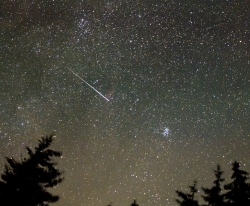
Courtesy NASA, Bill Ingalls, Photographer
Perseids debris comes from the Comet Swift-Tuttle, the largest object known to make repeated passes near the Earth. Its nucleus is about 6 miles across. Most of its meteoroids are the size of sand grains; a few are as big as peas or marbles. When they enter Earth’s atmosphere, they are called meteors. Almost none hit the ground, but if one does, it’s called a meteorite.
The Perseid shower is detectable from July 25-Aug 20, but meteor activity rises sharply around Aug. 12. For example, on the 25th you can expect to see a meteor every hour. Maybe 5 an hour by the 1st of August, up to 15 an hour by August 10th. But then on August 12, the number will spike to 50 -80 /hour and in some years up to 200! Then the number will quickly subside until Aug 20, when you’ll be back to 1 an hour.
Perseid meteoroids are fast. They enter Earth’s atmosphere at roughly 133,000 mph– or 60 km per second. They also make a sound! Fast-moving meteoroids ionize the air in their path leaving behind a trail that can briefly reflect radio wave from TV stations, RADAR facilities or AM/FM transmitters. A “radio meteor” is the short-lived echo of a radio signal that bounces off such a trail. Scientists at the NASA Marshall Space Flight Center in Huntsville, AL have established a radio meteor monitoring system. Here’s what a typical echo sounds like against some background static:
https://www.spaceweather.com/meteors/audio/geminidecho.wav (Editors note: Content AWOL as of 8/2021
Original article quoting sound found at https://www.spaceweather.com/glossary/nasameteorradar.html)
See NASA Radio Meteors: https://science.nasa.gov/search?search_api_views_text=radio+meteors (accessed August, 2021)
Hmmm… Kind of reminds me of a whale song.
This year, August 12th features a gibbous moon which means lunar glare will wipe out the path of the smaller meteroids . You’ll want to find a spot in the moonshade which will minimize glare. Or you can watch during predawn moonless hours on August 12th which will be the peak of this year’s show. No worries for those of us who can’t stay awake past midnight though. There will still be so-called shooting stars even while the moon is out—just less than when the moon has set. Furthermore, Jupiter is almost opposite to the sun with the planet coming physically closest to the Earth in its orbit . That means good viewing as Jupiter will appear very large. Look for it together with the moon in the constellation Sagittarius in the southeast sky. Depending upon your viewing equipment, you may be able to see some of Jupiter’s moons as well as the Great Red Spot, which is a gigantic hurricane-like storm twice the size of Earth on Jupiter’s surface.
For a sociable viewing experience, sky watchers in Northern Utah are invited to the Stokes Nature Center/American West Heritage Center Star Party August 12th from 9-1. We’ll have powerful telescopes, experienced interpreters, and all sorts of fun activities for adults and families. For more information see www.logannature.org or www.awhc.org
Credits:
Photo: Courtesy NASA, Bill Ingalls, Photographer, https://www.nasa.gov/image-feature/behold-the-perseid-meteor-shower
Text: Holly Strand, Stokes Nature Center
Additional Reading
Harbaugh, Jennifer, How many Perseids will I see in 2021?, NASA, August 9, 2021 https://blogs.nasa.gov/Watch_the_Skies/tag/perseids-meteor-shower/
McClure, Bruce, Perseid Meteor Shower 2021 Reaches Its Peak, EarthSky, August 10, 2021, https://earthsky.org/astronomy-essentials/everything-you-need-to-know-perseid-meteor-shower/
Pop! Ping! Perseids! Science@NASA (accessed July 31, 2008)
https://science.nasa.gov/newhome/headlines/ast13aug99_1.htm
Philipps, Tony. 2008. The 2008 Perseid Meteor Shower Science@NASA (accessed July 31, 2008)
Radio Meteor Listening.
https://www.spaceweather.com/glossary/forwardscatter.html (accessed July 31, 2008)
Ridpath, Ian. Oxford Dictionary of Astronomy. 1997.
NY: Oxford University Press
Harbaugh, Jennifer, How many Perseids will I see in 2021?, NASA, August 9, 2021 https://blogs.nasa.gov/Watch_the_Skies/tag/perseids-meteor-shower/
McClure, Bruce, Perseid Meteor Shower 2021 Reaches Its Peak, EarthSky, August 10, 2021, https://earthsky.org/astronomy-essentials/everything-you-need-to-know-perseid-meteor-shower/
